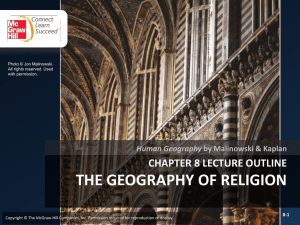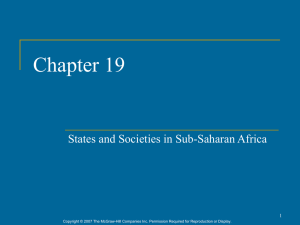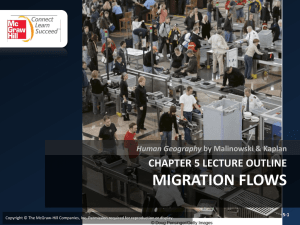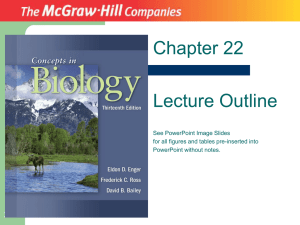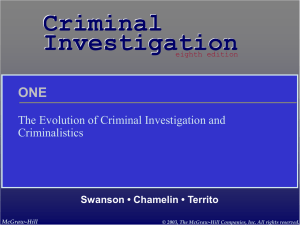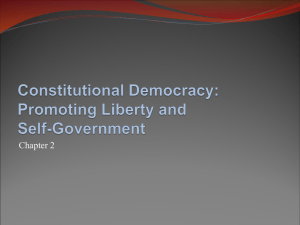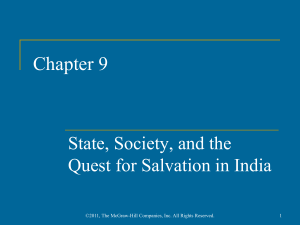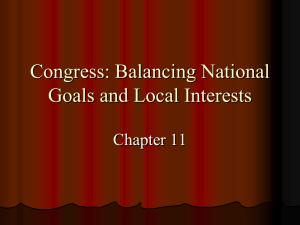Chapter 10 M-PPT - Miami Beach Senior High School
advertisement
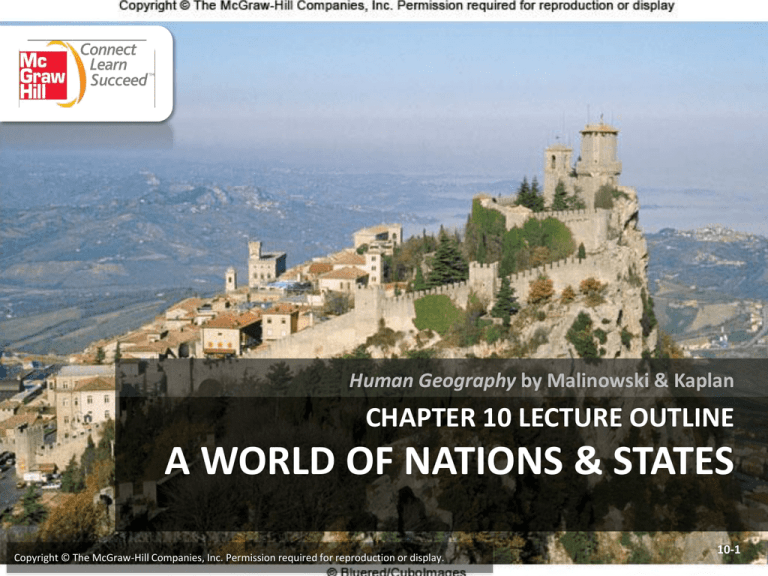
Human Geography by Malinowski & Kaplan CHAPTER 10 LECTURE OUTLINE A WORLD OF NATIONS & STATES Copyright © The McGraw-Hill Companies, Inc. Permission required for reproduction or display. 10-1 Chapter 10 Modules • • • • • • • • • 10A Sovereignty, Legitimacy, & Territoriality 10B History of Political Forms 10C History of States 10D Variations in Modern States 10E Four Markers of a Nation 10F The Relationship between Nations and States 10G Nationalism as an Ideology and Force in Statecraft 10H Boundaries and Borderlands 10I Geopolitics and the Global Order Copyright © The McGraw-Hill Companies, Inc. Permission required for reproduction or display. 10-2 10A: Sovereignty, Legitimacy, & Territoriality of Political Units 1 • Political Unit – Organizational entities at several different spatial scales that aid the study of political geography. The most important of these is the country, or state. • Sovereignty – Indicates that a state has complete control over a defined area • Legitimacy – Defines whether a government has the standing or right to rule a state’s people or territory Copyright © The McGraw-Hill Companies, Inc. Permission required for reproduction or display. 10-3 States of the World Copyright © The McGraw-Hill Companies, Inc. Permission required for reproduction or display. Figure 10A.1 10-4 10B: History of Political Forms • Tribal Groups or Chiefdoms • Often had no rigidly defined boundaries • Feudal Systems • City-States • Empires • Metropole: dominant part of the empire • Colonies: subordinate parts of an empire Copyright © The McGraw-Hill Companies, Inc. Permission required for reproduction or display. 10-5 The Roman Empire Copyright © The McGraw-Hill Companies, Inc. Permission required for reproduction or display. Figure 10B.3 10-6 10C: History of States • The Modern State System stems from: • The Westphalian state system • Treaty of Westphalia, 1648 • Clearly bounded, sovereign territories • The growth of nationalism & the nation-state • Europe’s impact on the rest of the world • Decolonization in the past two centuries Copyright © The McGraw-Hill Companies, Inc. Permission required for reproduction or display. 10-7 19th-Century Europe Copyright © The McGraw-Hill Companies, Inc. Permission required for reproduction or display. Figure 10C.2 10-8 10D: Variations in Modern States • Not all states are created equally • Satellite state • States with less than full sovereignty • Examples: Eastern European countries during the Soviet Union era • Sovereignty is not always universal • Homelands in South Africa were only recognized as states by the white South African government during the apartheid era • Micro-states Copyright © The McGraw-Hill Companies, Inc. Permission required for reproduction or display. 10-9 Apartheid-Era Homelands Copyright © The McGraw-Hill Companies, Inc. Permission required for reproduction or display. Figure 10D.2 10-10 Cyprus Copyright © The McGraw-Hill Companies, Inc. Permission required for reproduction or display. Figure 10D.3 10-11 Bosnia & Herzegovina Copyright © The McGraw-Hill Companies, Inc. Permission required for reproduction or display. Figure 10D.4 10-12 10E: Four Markers of a Nation 1. A shared cultural heritage or shared belief 2. Loyalty • • • Horizontal loyalty, i.e. loyalty to the nation, not forced by a ruler (vertical loyalty) Primary loyalty, transcending other allegiances Exclusivity, i.e. loyalty to just one nation 3. Territorial expression, a natural homeland 4. The quest for self-determination • A key component of nationalism Copyright © The McGraw-Hill Companies, Inc. Permission required for reproduction or display. 10-13 10F: The Relationship Between Nations & States • The nation-state ideal is that every nation has its own state, but this is unlikely • Multinational states are the norm • Multistate nations are those divided among many countries • Stateless nations are common • Nations may also be scattered to somewhere other than their homeland because of war or chaos – A diaspora Copyright © The McGraw-Hill Companies, Inc. Permission required for reproduction or display. 10-14 Canada’s Two Nations Copyright © The McGraw-Hill Companies, Inc. Permission required for reproduction or display. Figure 10F.2 10-15 The Arab “Nation” Copyright © The McGraw-Hill Companies, Inc. Permission required for reproduction or display. Figure 10F.3 10-16 Kurdistan Copyright © The McGraw-Hill Companies, Inc. Permission required for reproduction or display. Figure 10F.4 10-17 Overseas Chinese Copyright © The McGraw-Hill Companies, Inc. Permission required for reproduction or display. Figure 10F.5 10-18 10G: Nationalism as an Ideology and Force in Statecraft 1 • Three views on nations: – Primordialism • Nations are organically grown entities • Nationalism is just an awakening of something that already exists – Constructivism • Nations are artificial constructions from modernization and the goals of the elite – Instrumentalism • Nations arise to meet the needs of a particular situation Copyright © The McGraw-Hill Companies, Inc. Permission required for reproduction or display. 10-19 10G: Nationalism as an Ideology and Force in Statecraft 2 • Centripetal Forces – Forces that help to unify a state, such as a strong national identity – Unifying institutions such as a national military, a common church, or a great infrastructure • Centrifugal Forces – Forces that pull apart and disperse – Ethnoregionalism when a minority national group is concentrated in a particular area – Irredentist movements that seek to leave a state to join similar peoples on the other side of a border Copyright © The McGraw-Hill Companies, Inc. Permission required for reproduction or display. 10-20 Eritrea Copyright © The McGraw-Hill Companies, Inc. Permission required for reproduction or display. Figure 10G.2 10-21 10H: Boundaries & Borderlands 1 • Boundaries are an essential aspect of a political unit • International boundaries are recognized lines that separate one state from another • A borderland is the area that surrounds the boundary – A border is an area, a boundary is a line • Effective national territory can include legally controlled territory (de jure area) and sometimes other areas controlled (de facto area) Copyright © The McGraw-Hill Companies, Inc. Permission required for reproduction or display. 10-22 10H: Boundaries & Borderlands 2 • Natural boundaries – When natural features divide countries • Geometric boundaries – Lines drawn on a map without much interest in what is on the landscape • Subsequent boundaries – Created after recognized settlement – Often drawn to separate existing cultural groups • Antecedent boundaries – Boundaries created before an area is known or populated Copyright © The McGraw-Hill Companies, Inc. Permission required for reproduction or display. 10-23 10H: Boundaries & Borderlands 3 • International boundaries have many functions: 1. Boundaries disrupt traffic (goods, people, information) • Such as militarized boundaries 2. Separate governments & economic systems 3. Help embody the edge of national identity Copyright © The McGraw-Hill Companies, Inc. Permission required for reproduction or display. 10-24 Euroregions Copyright © The McGraw-Hill Companies, Inc. Permission required for reproduction or display. Figure 10H.12 10-25 10I: Geopolitics & the Global Order 1 • Geopolitics – The study of how geographical space—including the types of interrelationships between states, the different functions of states, and the different patterns of states—affects global politics. – Key early thinkers were Mackinder, Mahan, De Seversky – Also many used by Nazis to justify German expansion • Lebensraum, or living space Copyright © The McGraw-Hill Companies, Inc. Permission required for reproduction or display. 10-26 Mackinder’s View Copyright © The McGraw-Hill Companies, Inc. Permission required for reproduction or display. Figure 10I.1 10-27 10I: Geopolitics & the Global Order 2 • U.S. foreign policy after World War II – Containment to stop Soviet influence in nonaligned countries • George Kennan – Belief in the domino theory, or a fear that if one country became communist, others would follow, like falling dominos Copyright © The McGraw-Hill Companies, Inc. Permission required for reproduction or display. 10-28 10I: Geopolitics & the Global Order 3 • Post-Cold War geopolitics: – Geopolitical regions formed by spatial contiguity and political, cultural, military, & economic interaction – Shatterbelts • Regions that are politically fragmented and often zones of competition between ideological or religious realms • Critical geopolitics: – Used to dissect the ways state boundaries are perceived, relationships between states, and the ways the world is portrayed Copyright © The McGraw-Hill Companies, Inc. Permission required for reproduction or display. 10-29

